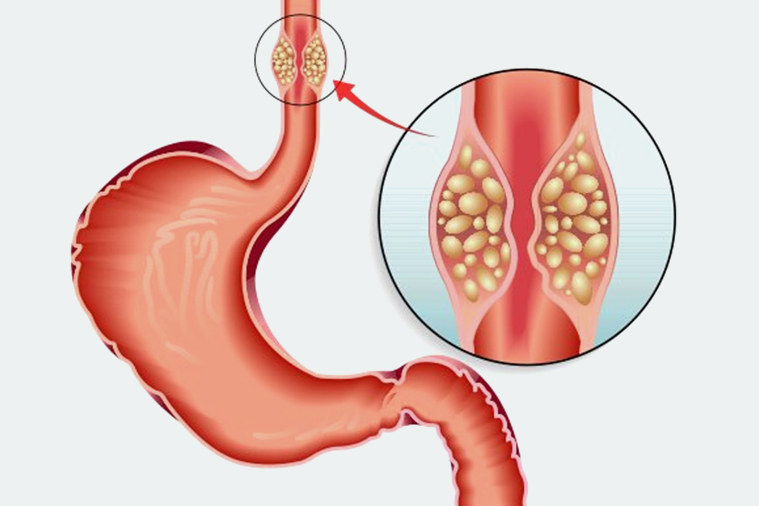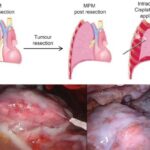Malignant neoplasm of the gastroesophageal junction (GEJ) is a severe and aggressive cancer affecting the area where the esophagus meets the stomach. This condition is primarily associated with adenocarcinoma and is influenced by risk factors such as gastroesophageal reflux disease (GERD), Barrett’s esophagus, and lifestyle factors. Early detection is crucial for improving patient outcomes.

Causes and Risk Factors
Several factors contribute to the development of malignant neoplasm of the gastroesophageal junction:
- Gastroesophageal Reflux Disease (GERD): Chronic acid reflux damages the esophageal lining, increasing cancer risk.
- Barrett’s Esophagus: A precancerous condition in which normal esophageal cells are replaced with abnormal ones due to prolonged GERD.
- Obesity: Excess body weight increases intra-abdominal pressure, leading to chronic reflux and esophageal damage.
- Dietary Factors: High intake of processed meats, low fruit and vegetable consumption, and alcohol abuse elevate cancer risks.
- Smoking: Tobacco use significantly increases the likelihood of esophageal and gastric cancers.
- Genetic Factors: A family history of upper gastrointestinal cancers may indicate a higher predisposition.
Symptoms of GEJ Malignancy
Early-stage malignant neoplasm of the gastroesophageal junction may be asymptomatic, but as the disease progresses, symptoms include:
- Difficulty swallowing (dysphagia)
- Persistent heartburn or acid reflux
- Unexplained weight loss
- Chronic cough or hoarseness
- Chest pain or discomfort
- Vomiting, sometimes with blood
Diagnosis and Staging
Diagnosing GEJ malignancy involves multiple tests to determine the presence, type, and extent of the disease.
Diagnostic Methods:
- Endoscopy with Biopsy: A flexible tube with a camera is inserted through the mouth to examine the esophagus and collect tissue samples.
- Barium Swallow X-ray: A contrast liquid highlights abnormalities in the esophagus and stomach.
- CT and PET Scans: Imaging tests help detect tumor spread to nearby organs and lymph nodes.
- Endoscopic Ultrasound (EUS): Determines tumor depth and lymph node involvement.
- Molecular Testing: Identifies genetic mutations such as HER2 overexpression, guiding targeted therapy decisions.
Staging:
- Stage 0: Precancerous cells without invasion
- Stage I: Small tumor localized to the esophageal lining
- Stage II: Tumor spreads to deeper layers or lymph nodes
- Stage III: Cancer extends to surrounding tissues
- Stage IV: Distant metastases present
Treatment Options
The treatment approach depends on cancer stage, tumor location, and overall patient health.
Surgical Interventions:
- Esophagectomy: Removal of the affected part of the esophagus, often with reconstruction using stomach or intestinal tissue.
- Gastroesophagectomy: Surgical removal of part of the stomach and esophagus, followed by reconstruction.
Chemotherapy and Radiation Therapy:
- Neoadjuvant Chemotherapy: Administered before surgery to shrink tumors.
- Adjuvant Chemotherapy: Given post-surgery to eliminate residual cancer cells.
- Radiation Therapy: Often combined with chemotherapy to improve treatment efficacy.
Targeted Therapy and Immunotherapy:
- HER2-Targeted Therapy: Drugs like trastuzumab (Herceptin) are effective for HER2-positive tumors.
- PD-1/PD-L1 Inhibitors: Immunotherapy drugs boost the body’s immune response against cancer cells.
Palliative Care:
For advanced-stage cancer, palliative treatments focus on symptom relief, including:
- Endoscopic stent placement to improve swallowing
- Pain management
- Nutritional support
Prognosis and Survival Rates
Survival rates depend on the stage at diagnosis. Early-stage cancers have a significantly better prognosis than advanced cases. Advances in early detection, personalized treatment plans, and emerging therapies continue to improve patient outcomes.
Malignant neoplasm of the gastroesophageal junction is a complex and aggressive cancer requiring timely diagnosis and a multidisciplinary treatment approach. Awareness of risk factors, symptoms, and available treatment options is crucial for improving outcomes. Continued research and advancements in targeted therapy provide hope for better prognosis and survival rates.

